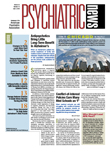There is a slightly increased risk of being involved in a traffic accident after having been dispensed an antidepressant. This is the case whether the antidepressant is one of the older sedating types or one of the newer nonsedating ones.
However, whether the increased risk is actually due to antidepressant use, to being depressed, or to some other factor is unknown.
These findings emerged from a large population study conducted in Norway. The lead investigator was Jorgen Bramness, M.D., Ph.D., a psychiatrist and senior researcher at the Norwegian Institute of Public Health in Oslo. Results were published in the June 3 online edition of the Journal of Clinical Psychiatry.
Bramness and colleagues used three population-based registries in Norway to obtain data for their study—the Central Population Registry, the Prescription Database, and the Road Accident Registry.
Using the Central Population Registry, the investigators focused on some 3 million Norwegians aged 18 to 69 who had been included in the registry from 2004 to 2006.
Using the Prescription Database, Bramness and his colleagues determined which of the 3 million Norwegians had filled prescriptions for antidepressants, on what date, for which kind of antidepressant, and for how many days of use, during the 2004 to 2006 period. (The database did not provide information on actual antidepressant use, but the researchers assumed that individuals who filled antidepressant prescriptions used them.)
And using the Road Accident Registry, Bramness and his group determined which of the 3 million had been involved, as motor-vehicle drivers, in traffic accidents causing personal injuries, and on what date, from 2004 to 2006. (The registry did not say who was responsible for these accidents.)
The researchers then tabulated the number of traffic accidents with personal injuries in which the 3 million Norwegians had been involved from 2004 to 2006, finding 20,494 such incidents. They then assessed how many of the drivers involved in those accidents had been dispensed older sedating antidepressants such as the tricyclics, newer nonsedating antidepressants such as the selective serotonin reuptake inhibitors, or no antidepressants. They found that 204 had been dispensed older sedating antidepressants before the accidents, 884 had been dispensed nonsedating ones, and the remaining 19,406 had not been dispensed any antidepressants prior to the accidents.
The researchers then assessed the risks for experiencing a traffic accident with personal injury in these three groups of drivers. There was a statistically significant, although modest, increased risk for the two groups that had been dispensed antidepressants. The standardized incidence ratios were 1.4 for those getting older sedating antidepressants and 1.6 for those getting newer nonsedating ones.
The risks were similar for both male and female drivers and did not change even when the coprescribing of benzodiazepines or opioids was taken into consideration.
Finally, they determined whether the traffic-accident risk for persons who had been dispensed an antidepressant for the first time (presumably new users) was the same as that for individuals who had previously been dispensed antidepressants. They found that new users of the newer antidepressants had a traffic-accident risk similar to that incurred by seasoned users of either the older or newer antidepressants. However, they also found that new users of the older antidepressants had no higher traffic-accident risk than nonantidepressant users did.
Several of these results surprised Bramness, he told Psychiatric News. First, he had expected that the older antidepressants would be linked with a higher traffic-accident risk than the newer ones because of their sedating qualities. They did not find this, however. Second, he had expected that new antidepressant users would be linked with a higher traffic-accident risk than experienced antidepressant users, because a person not used to taking a drug might be at higher risk due to side effects. But they found this to be true only for the newer antidepressants.
So, what to make of these results? “First of all, we found only a slight increase in traffic-accident risk for patients on antidepressants,” Bramness said. “The risk was much lower than for drugs like benzodiazepines, opioid analgesics, or carisoprodol (Soma). Still, physicians should be aware that patients on antidepressants may be at a higher risk of being involved in traffic accidents. This is not a reason for not giving antidepressants, and we cannot say on the basis of this research if one drug is better than the other. It may be wise to discuss driving with your patients. If they are still depressed or feel incapacitated by the medication, they should have someone drive them.”
There was no outside funding for the study.
An abstract of “Minor Increase in Risk of Road Traffic Accidents After Prescriptions of Antidepressants: A Study of Population Registry Data in Norway” is posted at<www.psychiatrist.com/abstracts/abstracts.asp?abstract=oap/ej07m03661.htm>.▪
